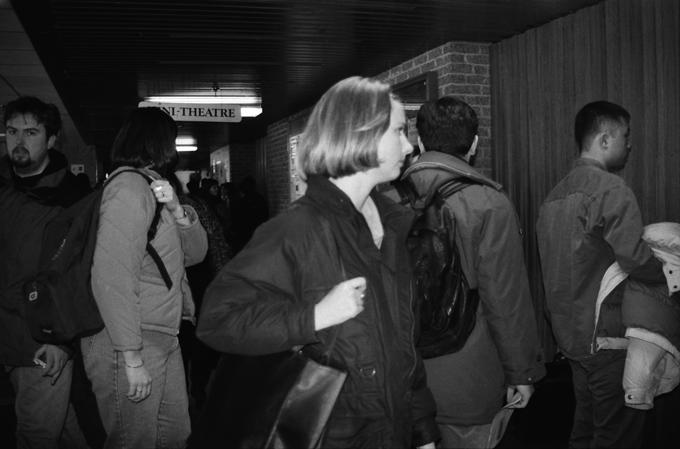By Hamida Ghafour
RyeSAC president David Steel’s voice booms in The Hub as he tests the mic. It still isn’t loud enough so he turns up the volume so the candidates running for RyeSAC president can be heard by students busily scarfing down their pizza and cheeseburgers. But their voices only intermittently break through the din of the lunchroom crowd. A few curious passers-by pause for a minute, realize it’s a political debate, and walk away. The debate continues without any fanfare. The scene is one that’s been played out before. When it comes to student politics, students’ response is one of indifference.
Last year, only 11 per cent of Ryerson’s approximately 12,000 eligible student voters cast ballots in the school’s student council executive elections. Although the voter turnout has remained stagnant since the early 1990s, the number of student voters has decreased since the school opened 50 years ago. Perhaps the biggest hurdle in getting more student to vote is that RyeSAC refuses to acknowledge it has a voter turnout problem. When pressed for solutions, the student government doesn’t have one concrete suggestion to offer. And this year’s presidential hopefuls Erin George and Elliot Salmons have resigned themselves to an old standby excuse — Ryerson is a commuter school and therefore, no one gets involved with school activities.
But if RyeSAC is to bring about real change, such as winning a tuition freeze, getting more students to participate in the electoral process is crucial, says Mike Burke, a politics professor at Ryerson. In federal, provincial and municipal elections, candidates go door to door to introduce themselves to the voters. A Ryerson, Burke says, most students don’t even know who’s running.
“Here, a lot of students don’t realize votes have been held,” he says. “It might help if universities would have a period where they don’t have classes when students can vote.”
But Ryerson’s apathy woes are as old as the school itself. There have only been a few bright spots. In the 1940s, council called the student body apathetic when a mere 52 per cent came out to vote. In the mid-1950s, the school flirted with a two-party partisan system — the Blue and the Gold. A record 80 per cent came out to cast their ballots, the majority voting for the Blue party, who promised to increase school spirit. But the novelty of the partisan system wore off and in 1958, Blue became the sole party on campus.
The lack of opposition prompted journalism professor Don Obe, who then was editor-in-chief of the Ryersonian, to slam students in a front page editorial: “[They] only concern themselves with [student council] matters when their own interests are at stake and must shoulder the blame for the disintegration of Ryerson’s only representative institution.”
Apathy around election time isn’t just a university problem. Federal, provincial and municipal politicians all have a tough time getting high school, college and university students to cast votes in their elections.
Walied Soliman, president of Ontario’s Progressive Conservative Youth Pary, says he longs for the electoral passion students displayed in the past. During a PC youth conference last year, Soliman recalls walking around Maple Leaf Gardens solemnly, upset that less than 1,000 students showed up to hear the party’s 1947 president speak. During his walk, he found a photo of the 1930 PC youth conference — the stands in the Gardens were jam-packed.
“I remember looking at it and asking the 1947 president why they had so many members back then. ‘It’s very simple,’ he answered. ‘There was no television,’” says Soliman, a first-year law student at Osgoode Hall.
Yet unlike Steele, George and Salmons, Soliman hasn’t resigned himself to accept that students will never be that interested in the political process. He believes one reason why students don’t bother to vote is because candidates don’t give them a compelling reason to.
“In an era of political correctness, there is a real sense of not taking a stand because not taking a stand is the best stand you can take,” Soliman says.
This was evident during the debate in The Hub. George and Salmons took the same stance on almost every issue. When Salmons said he would pull students’ money out of the student campus centre if it wasn’t student-run, George integrated his point when it was her turn to respond.
“Once again, I completely agree with Elliot. I think the focus of the student centre has to be the students,” she said.
If candidates won’t engage in a lively debate, Soliman says that lifting regulations on how much each candidate can spend on their campaign would help raise more interest. More voters would come out, he argues, if campaigns were allowed to be creative and lavish as opposed to the standard fluorescent paper that posters Ryerson’s campus. He says candidates should be able to come up with creative ways to fund their campaigns.
While Soliman doesn’t think allowing an unlimited campaign budget would favour wealthier candidates, Steele believes it would exclude some students with good ideas from running because they couldn’t afford to. RyeSAC currently allows presidential candidates to spend no more than $300 during their two-week campaigns.
The debate is already 15 minutes old, and yet the seats in front of George and Salmons remain empty except for a few journalism students. A reporter asks what strategies the two presidential candidates have been working on to address the problem of student apathy toward RyeSAC and its elections. Both tiptoe around the question and offer these responses: “[Students’] trust. They have faith in the organization and they’re interested in who’s running it, but they’re not as interested because they faith that somebody will take care of it,” says Salmons.
“Usually you only hear feedback when it’s negative feedback,” George says.
“And so a lot of the times if students aren’t very interested in us, I guess they are not up in arms about RyeSAC and they’re pretty happy with what we are doing.”










Leave a Reply